Experimentally Deduced Criteria for Detection of Clinically Relevant Fusion 3′ Oncogenes from FFPE Bulk RNA Sequencing Data
Abstract
1. Introduction
2. Materials and Methods
2.1. Biosamples and RNA Sequencing
2.2. Bioinformatic Identification of RTK Fusion Transcripts
2.3. Experimental Validation of RTK Fusion Transcripts
2.4. Exon Coverage Calculation
3. Results
4. Discussion
Supplementary Materials
Author Contributions
Funding
Institutional Review Board Statement
Informed Consent Statement
Data Availability Statement
Conflicts of Interest
References
- Yoshihara, K.; Wang, Q.; Torres-Garcia, W.; Zheng, S.; Vegesna, R.; Kim, H.; Verhaak, R.G.W. The Landscape and Therapeutic Relevance of Cancer-Associated Transcript Fusions. Oncogene 2015, 34, 4845–4854. [Google Scholar] [CrossRef] [PubMed]
- Stransky, N.; Cerami, E.; Schalm, S.; Kim, J.L.; Lengauer, C. The Landscape of Kinase Fusions in Cancer. Nat. Commun. 2014, 5, 354. [Google Scholar] [CrossRef] [PubMed]
- Doebele, R.C.; Drilon, A.; Paz-Ares, L.; Siena, S.; Shaw, A.T.; Farago, A.F.; Blakely, C.M.; Seto, T.; Cho, B.C.; Tosi, D.; et al. Entrectinib in Patients with Advanced or Metastatic NTRK Fusion-Positive Solid Tumours: Integrated Analysis of Three Phase 1–2 Trials. Lancet Oncol. 2020, 21, 271–282. [Google Scholar] [CrossRef]
- Farago, A.F.; Demetri, G.D. Larotrectinib, a Selective Tropomyosin Receptor Kinase Inhibitor for Adult and Pediatric Tropomyosin Receptor Kinase Fusion Cancers. Future Oncol. 2020, 16, 417–425. [Google Scholar] [CrossRef]
- Looney, A.M.; Nawaz, K.; Webster, R.M. Tumour-Agnostic Therapies. Nat. Rev. Drug Discov. 2020, 19, 383–385. [Google Scholar] [CrossRef]
- Arreaza, G.; Qiu, P.; Pang, L.; Albright, A.; Hong, L.Z.; Marton, M.J.; Levitan, D. Pre-Analytical Considerations for Successful next-Generation Sequencing (NGS): Challenges and Opportunities for Formalin-Fixed and Paraffin-Embedded Tumor Tissue (FFPE) Samples. Int. J. Mol. Sci. 2016, 17, 1579. [Google Scholar] [CrossRef]
- Thompson, L.L.; Jeusset, L.M.P.; Lepage, C.C.; McManus, K.J. Evolving Therapeutic Strategies to Exploit Chromosome Instability in Cancer. Cancers 2017, 9, 151. [Google Scholar] [CrossRef]
- Ali, J.; Khan, S.A.; Shan-e-Rauf; Ayyub, M.; Ali, N.; Afridi, N.K. Comparative Analysis of Fluorescence in Situ Hybridization and Real Time Polymerase Chain Reaction in Diagnosis of Chronic Myeloid Leukemia. J. Coll. Physicians Surg. Pak. 2017, 27, 26–29. [Google Scholar]
- De Luca, A.; Abate, R.E.; Rachiglio, A.M.; Maiello, M.R.; Esposito, C.; Schettino, C.; Izzo, F.; Nasti, G.; Normanno, N. FGFR Fusions in Cancer: From Diagnostic Approaches to Therapeutic Intervention. Int. J. Mol. Sci. 2020, 21, 6856. [Google Scholar] [CrossRef] [PubMed]
- Thorne-Nuzzo, T.; Williams, C.; Catallini, A.; Clements, J.; Singh, S.; Amberson, J.; Dickinson, K.; Gatalica, Z.; Ho, S.N.; Loftin, I.; et al. A Sensitive ALK Immunohistochemistry Companion Diagnostic Test Identifies Patients Eligible for Treatment with Crizotinib. J. Thorac. Oncol. 2017, 12, 804–813. [Google Scholar] [CrossRef] [PubMed]
- Boyle, T.A.; Masago, K.; Ellison, K.E.; Yatabe, Y.; Hirsch, F.R. ROS1 Immunohistochemistry among Major Genotypes of Non-Small-Cell Lung Cancer. Clin. Lung Cancer 2015, 16, 106–111. [Google Scholar] [CrossRef] [PubMed]
- Cruz-Rico, G.; Avilés-Salas, A.; Segura-González, M.; Espinosa-García, A.M.; Ramírez-Tirado, L.A.; Morales-Oyarvide, V.; Rojas-Marín, C.; Cardona, A.F.; Arrieta, O. Diagnosis of EML4-ALK Translocation with FISH, Immunohistochemistry, and Real-Time Polymerase Chain Reaction in Patients with Non-Small Cell Lung Cancer. Am. J. Clin. Oncol. Cancer Clin. Trials 2017, 40, 631–638. [Google Scholar] [CrossRef]
- Abbou, S.; Finstuen-Magro, S.; McDannell, B.; Feenstra, M.; Ward, A.; Shulman, D.S.; Geoerger, B.; Duplan, J.; Comeau, H.; Janeway, K.A.; et al. Rapid and Highly Sensitive Approach for Multiplexed Somatic Fusion Detection. Mod. Pathol. 2022, 35, 1022–1033. [Google Scholar] [CrossRef]
- Heydt, C.; Wölwer, C.B.; Velazquez Camacho, O.; Wagener-Ryczek, S.; Pappesch, R.; Siemanowski, J.; Rehker, J.; Haller, F.; Agaimy, A.; Worm, K.; et al. Detection of Gene Fusions Using Targeted Next-Generation Sequencing: A Comparative Evaluation. BMC Med. Genom. 2021, 14, 62. [Google Scholar] [CrossRef]
- Davies, K.D.; Le, A.T.; Sheren, J.; Nijmeh, H.; Gowan, K.; Jones, K.L.; Varella-Garcia, M.; Aisner, D.L.; Doebele, R.C. Comparison of Molecular Testing Modalities for Detection of ROS1 Rearrangements in a Cohort of Positive Patient Samples. J. Thorac. Oncol. 2018, 13, 1474–1482. [Google Scholar] [CrossRef]
- Benayed, R.; Offin, M.; Mullaney, K.; Sukhadia, P.; Rios, K.; Desmeules, P.; Ptashkin, R.; Won, H.; Chang, J.; Halpenny, D.; et al. High Yield of RNA Sequencing for Targetable Kinase Fusions in Lung Adenocarcinomas with No Mitogenic Driver Alteration Detected by DNA Sequencing and Low Tumor Mutation Burden. Clin. Cancer Res. 2019, 25, 4712–4722. [Google Scholar] [CrossRef]
- Buzdin, A.; Tkachev, V.; Zolotovskaia, M.; Garazha, A.; Moshkovskii, S.; Borisov, N.; Gaifullin, N.; Sorokin, M.; Suntsova, M. Using Proteomic and Transcriptomic Data to Assess Activation of Intracellular Molecular Pathways. In Advances in Protein Chemistry and Structural Biology; Academic Press: Cambridge, MA, USA, 2021; Volume 127. [Google Scholar]
- Sorokin, M.; Poddubskaya, E.; Baranova, M.; Glusker, A.; Kogoniya, L.; Markarova, E.; Allina, D.; Suntsova, M.; Tkachev, V.; Garazha, A.; et al. RNA Sequencing Profiles and Diagnostic Signatures Linked with Response to Ramucirumab in Gastric Cancer. Cold Spring Harb. Mol. Case Stud. 2020, 6, a004945. [Google Scholar] [CrossRef]
- Sorokin, M.; Kholodenko, I.; Kalinovsky, D.; Shamanskaya, T.; Doronin, I.; Konovalov, D.; Mironov, A.; Kuzmin, D.; Nikitin, D.; Deyev, S.; et al. RNA Sequencing-Based Identification of Ganglioside GD2-Positive Cancer Phenotype. Biomedicines 2020, 8, 142. [Google Scholar] [CrossRef]
- Buzdin, A.; Sorokin, M.; Garazha, A.; Sekacheva, M.; Kim, E.; Zhukov, N.; Wang, Y.; Li, X.; Kar, S.; Hartmann, C.; et al. Molecular Pathway Activation—New Type of Biomarkers for Tumor Morphology and Personalized Selection of Target Drugs. Semin. Cancer Biol. 2018, 53, 110–124. [Google Scholar] [CrossRef]
- Sorokin, M.; Gorelyshev, A.; Efimov, V.; Zotova, E.; Zolotovskaia, M.; Rabushko, E.; Kuzmin, D.; Seryakov, A.; Kamashev, D.; Li, X.; et al. RNA Sequencing Data for FFPE Tumor Blocks Can Be Used for Robust Estimation of Tumor Mutation Burden in Individual Biosamples. Front. Oncol. 2021, 11, 732644. [Google Scholar] [CrossRef]
- Samii, A.; Sorokin, M.; Kar, S.; Makovskaia, L.; Garazha, A.; Hartmann, C.; Moisseev, A.; Kim, E.; Giese, A.; Buzdin, A. Case of Multifocal Glioblastoma with Four Fusion Transcripts of ALK, FGFR2, NTRK2, and NTRK3 Genes Stresses the Need for Tumor Tissue Multisampling for Transcriptomic Analysis. Cold Spring Harb. Mol. Case Stud. 2021, 7, a006100. [Google Scholar] [CrossRef]
- Konovalov, N.; Timonin, S.; Asyutin, D.; Raevskiy, M.; Sorokin, M.; Buzdin, A.; Kaprovoy, S. Transcriptomic Portraits and Molecular Pathway Activation Features of Adult Spinal Intramedullary Astrocytomas. Front. Oncol. 2022, 12, 837570. [Google Scholar] [CrossRef]
- Borisov, N.; Sergeeva, A.; Suntsova, M.; Raevskiy, M.; Gaifullin, N.; Mendeleeva, L.; Gudkov, A.; Nareiko, M.; Garazha, A.; Tkachev, V.; et al. Machine Learning Applicability for Classification of PAD/VCD Chemotherapy Response Using 53 Multiple Myeloma RNA Sequencing Profiles. Front. Oncol. 2021, 11, 652063. [Google Scholar] [CrossRef] [PubMed]
- Vladimirova, U.; Rumiantsev, P.; Zolotovskaia, M.; Albert, E.; Abrosimov, A.; Slashchuk, K.; Nikiforovich, P.; Chukhacheva, O.; Gaifullin, N.; Suntsova, M.; et al. DNA Repair Pathway Activation Features in Follicular and Papillary Thyroid Tumors, Interrogated Using 95 Experimental RNA Sequencing Profiles. Heliyon 2021, 7, e06408. [Google Scholar] [CrossRef] [PubMed]
- Seryakov, A.; Magomedova, Z.; Suntsova, M.; Prokofieva, A.; Rabushko, E.; Glusker, A.; Makovskaia, L.; Zolotovskaia, M.; Buzdin, A.; Sorokin, M. RNA Sequencing for Personalized Treatment of Metastatic Leiomyosarcoma: Case Report. Front. Oncol. 2021, 11, 666001. [Google Scholar] [CrossRef]
- Jørgensen, J.T. The Current Landscape of the FDA Approved Companion Diagnostics. Transl. Oncol. 2021, 14, 101063. [Google Scholar] [CrossRef]
- Haas, B.J.; Dobin, A.; Li, B.; Stransky, N.; Pochet, N.; Regev, A. Accuracy Assessment of Fusion Transcript Detection via Read-Mapping and de Novo Fusion Transcript Assembly-Based Methods. Genome Biol. 2019, 20, 213. [Google Scholar] [CrossRef] [PubMed]
- Creason, A.; Haan, D.; Dang, K.; Chiotti, K.E.; Inkman, M.; Lamb, A.; Yu, T.; Hu, Y.; Norman, T.C.; Buchanan, A.; et al. A Community Challenge to Evaluate RNA-Seq, Fusion Detection, and Isoform Quantification Methods for Cancer Discovery. Cell Syst. 2021, 12, 827–838. [Google Scholar] [CrossRef] [PubMed]
- Uhrig, S.; Ellermann, J.; Walther, T.; Burkhardt, P.; Fröhlich, M.; Hutter, B.; Toprak, U.H.; Neumann, O.; Stenzinger, A.; Scholl, C.; et al. Accurate and Efficient Detection of Gene Fusions from RNA Sequencing Data. Genome Res. 2021, 31, 448–460. [Google Scholar] [CrossRef]
- Suntsova, M.; Gaifullin, N.; Allina, D.; Reshetun, A.; Li, X.; Mendeleeva, L.; Surin, V.; Sergeeva, A.; Spirin, P.; Prassolov, V.; et al. Atlas of RNA Sequencing Profiles for Normal Human Tissues. Sci. Data 2019, 6, 11. [Google Scholar] [CrossRef]
- Li, F.; Peiris, M.N.; Donoghue, D.J. Functions of FGFR2 Corrupted by Translocations in Intrahepatic Cholangiocarcinoma. Cytokine Growth Factor Rev. 2020, 52, 56–67. [Google Scholar] [CrossRef] [PubMed]
- Nord, K.H.; Lilljebjörn, H.; Vezzi, F.; Nilsson, J.; Magnusson, L.; Tayebwa, J.; de Jong, D.; Bovée, J.V.M.G.; Hogendoorn, P.C.W.; Szuhai, K. GRM1 Is Upregulated through Gene Fusion and Promoter Swapping in Chondromyxoid Fibroma. Nat. Genet. 2014, 46, 474–477. [Google Scholar] [CrossRef] [PubMed]
- Gallo, L.H.; Nelson, K.N.; Meyer, A.N.; Donoghue, D.J. Functions of Fibroblast Growth Factor Receptors in Cancer Defined by Novel Translocations and Mutations. Cytokine Growth Factor Rev. 2015, 26, 425–449. [Google Scholar] [PubMed]
- Frenkel-Morgenstern, M.; Lacroix, V.; Ezkurdia, I.; Levin, Y.; Gabashvili, A.; Prilusky, J.; del Pozo, A.; Tress, M.; Johnson, R.; Guigo, R.; et al. Chimeras Taking Shape: Potential Functions of Proteins Encoded by Chimeric RNA Transcripts. Genome Res. 2012, 22, 1231–1242. [Google Scholar] [CrossRef] [PubMed]
- Zhang, Z.; Chen, Z.; Jiang, M.; Liu, S.; Guo, Y.; Wan, L.; Li, F. Heterogeneous BCR-ABL1 Signal Patterns Identified by Fluorescence in Situ Hybridization Are Associated with Leukemic Clonal Evolution and Poorer Prognosis in BCR-ABL1 Positive Leukemia. BMC Cancer 2019, 19, 935. [Google Scholar] [CrossRef]
- Santoro, M.; Moccia, M.; Federico, G.; Carlomagno, F. Ret Gene Fusions in Malignancies of the Thyroid and Other Tissues. Genes 2020, 11, 424. [Google Scholar] [CrossRef]
- Sweeney, S.M.; Cerami, E.; Baras, A.; Pugh, T.J.; Schultz, N.; Stricker, T.; Lindsay, J.; del Vecchio Fitz, C.; Kumari, P.; Micheel, C.; et al. AACR Project Genie: Powering Precision Medicine through an International Consortium. Cancer Discov. 2017, 7, 818–831. [Google Scholar] [CrossRef]
- Varga, K.; Hollósi, A.; Pászty, K.; Hegedűs, L.; Szakács, G.; Tímár, J.; Papp, B.; Enyedi, Á.; Padányi, R. Expression of Calcium Pumps Is Differentially Regulated by Histone Deacetylase Inhibitors and Estrogen Receptor Alpha in Breast Cancer Cells. BMC Cancer 2018, 18, 1029. [Google Scholar] [CrossRef]
- Khoshbakht, S.; Mokhtari, M.; Moravveji, S.S.; Azimzadeh Jamalkandi, S.; Masoudi-Nejad, A. Re-Wiring and Gene Expression Changes of AC025034.1 and ATP2B1 Play Complex Roles in Early-to-Late Breast Cancer Progression. BMC Genom. Data 2022, 23, 6. [Google Scholar] [CrossRef] [PubMed]
- Sorokin, M.; Ignatev, K.; Barbara, V.; Vladimirova, U.; Muraveva, A.; Suntsova, M.; Gaifullin, N.; Vorotnikov, I.; Kamashev, D.; Bondarenko, A.; et al. Molecular Pathway Activation Markers Are Associated with Efficacy of Trastuzumab Therapy in Metastatic HER2-Positive Breast Cancer Better than Individual Gene Expression Levels. Biochemistry 2020, 85, 758–772. [Google Scholar] [CrossRef]
- Najjar, S.; Allison, K.H. Updates on Breast Biomarkers. Virchows Arch. 2022, 480, 163–176. [Google Scholar] [CrossRef]
- Yu, D.H.; Tang, L.; Dong, H.; Dong, Z.; Zhang, L.; Fu, J.; Su, X.; Zhang, T.; Fu, H.; Han, L.; et al. Oncogenic HER2 Fusions in Gastric Cancer. J. Transl. Med. 2015, 13, 116. [Google Scholar] [CrossRef][Green Version]
- Bose, R. A Neu View of Invasive Lobular Breast Cancer. Clin. Cancer Res. 2013, 19, 3331–3333. [Google Scholar] [CrossRef]
- Abou-Alfa, G.K.; Sahai, V.; Hollebecque, A.; Vaccaro, G.; Melisi, D.; Al-Rajabi, R.; Paulson, A.S.; Borad, M.J.; Gallinson, D.; Murphy, A.G.; et al. Pemigatinib for Previously Treated, Locally Advanced or Metastatic Cholangiocarcinoma: A Multicentre, Open-Label, Phase 2 Study. Lancet Oncol. 2020, 21, 671–684. [Google Scholar] [CrossRef]
- Jain, A.; Borad, M.J.; Kelley, R.K.; Wang, Y.; Abdel-Wahab, R.; Meric-Bernstam, F.; Baggerly, K.A.; Kaseb, A.O.; Al-shamsi, H.O.; Ahn, D.H.; et al. Cholangiocarcinoma with FGFR Genetic Aberrations: A Unique Clinical Phenotype. JCO Precis. Oncol. 2018, 2, 1–12. [Google Scholar] [CrossRef]
- Kim, P.; Yiya, K.; Zhou, X. FGviewer: An Online Visualization Tool for Functional Features of Human Fusion Genes. Nucleic Acids Res. 2021, 48, W313–W320. [Google Scholar] [CrossRef] [PubMed]
- Zhao, Y.; Mehta, M.; Walton, A.; Talsania, K.; Levin, Y.; Shetty, J.; Gillanders, E.M.; Tran, B.; Carrick, D.M. Robustness of RNA Sequencing on Older Formalin-Fixed Paraffin-Embedded Tissue from High-Grade Ovarian Serous Adenocarcinomas. PLoS ONE 2019, 14, e0216050. [Google Scholar] [CrossRef]
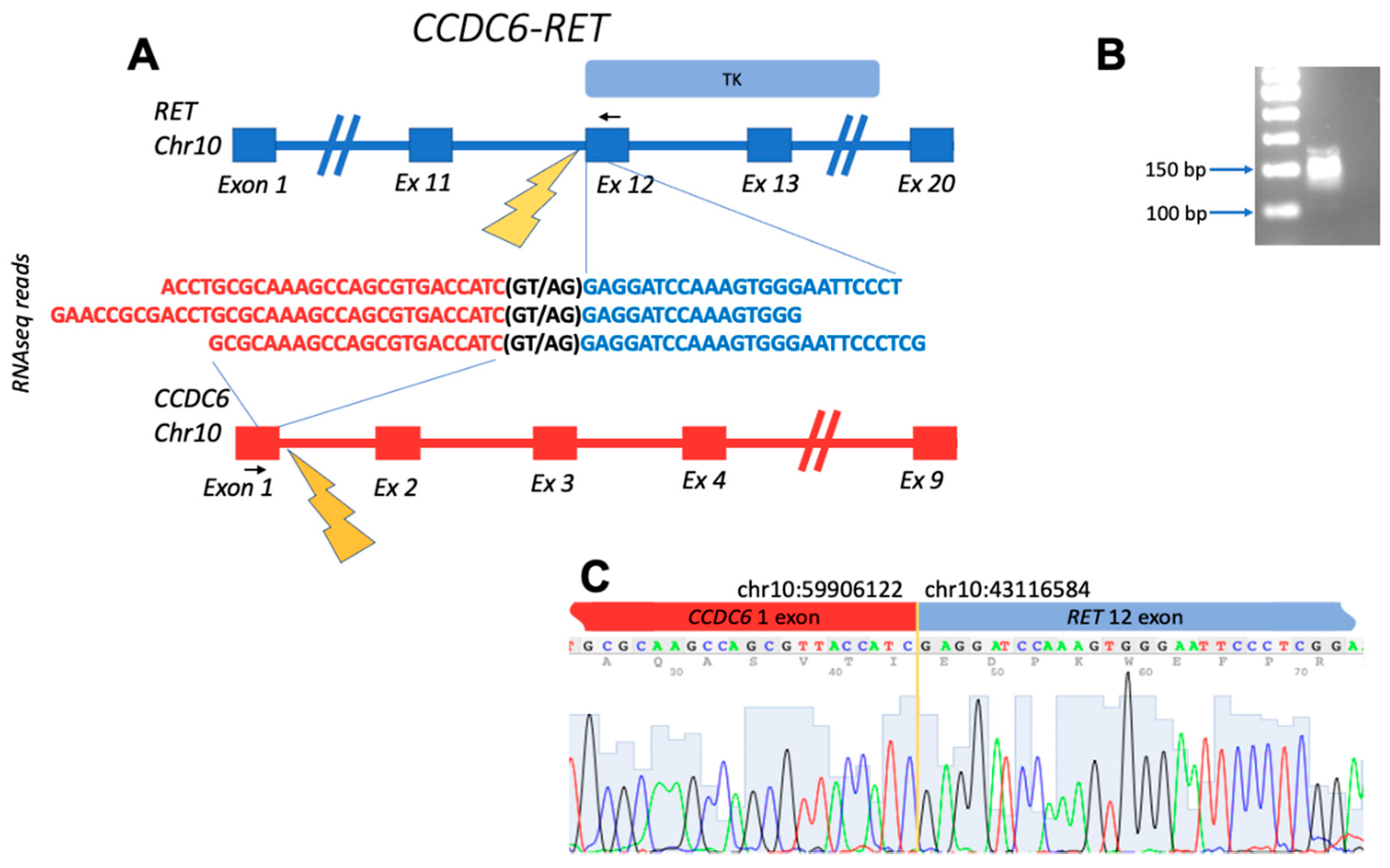
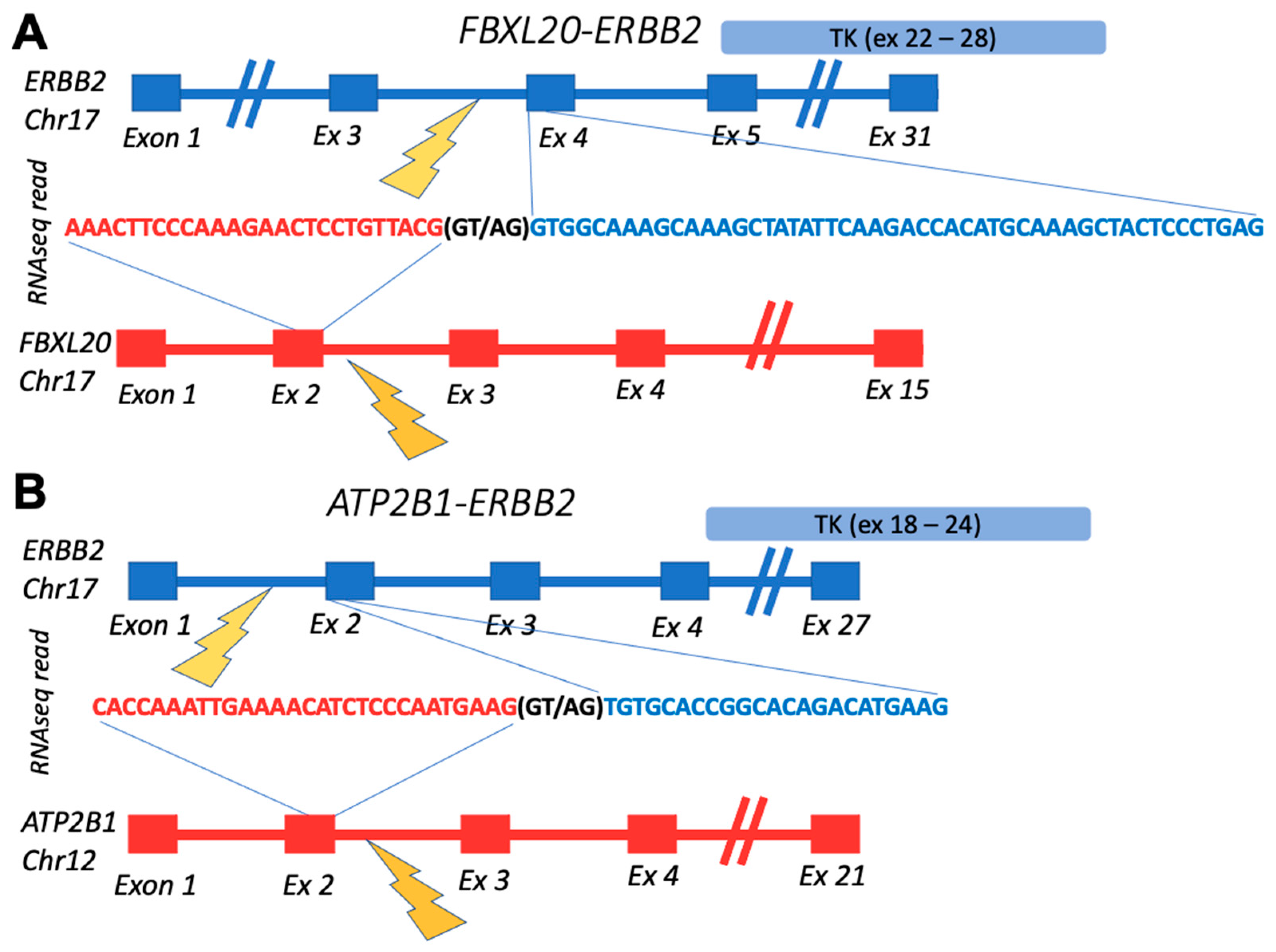
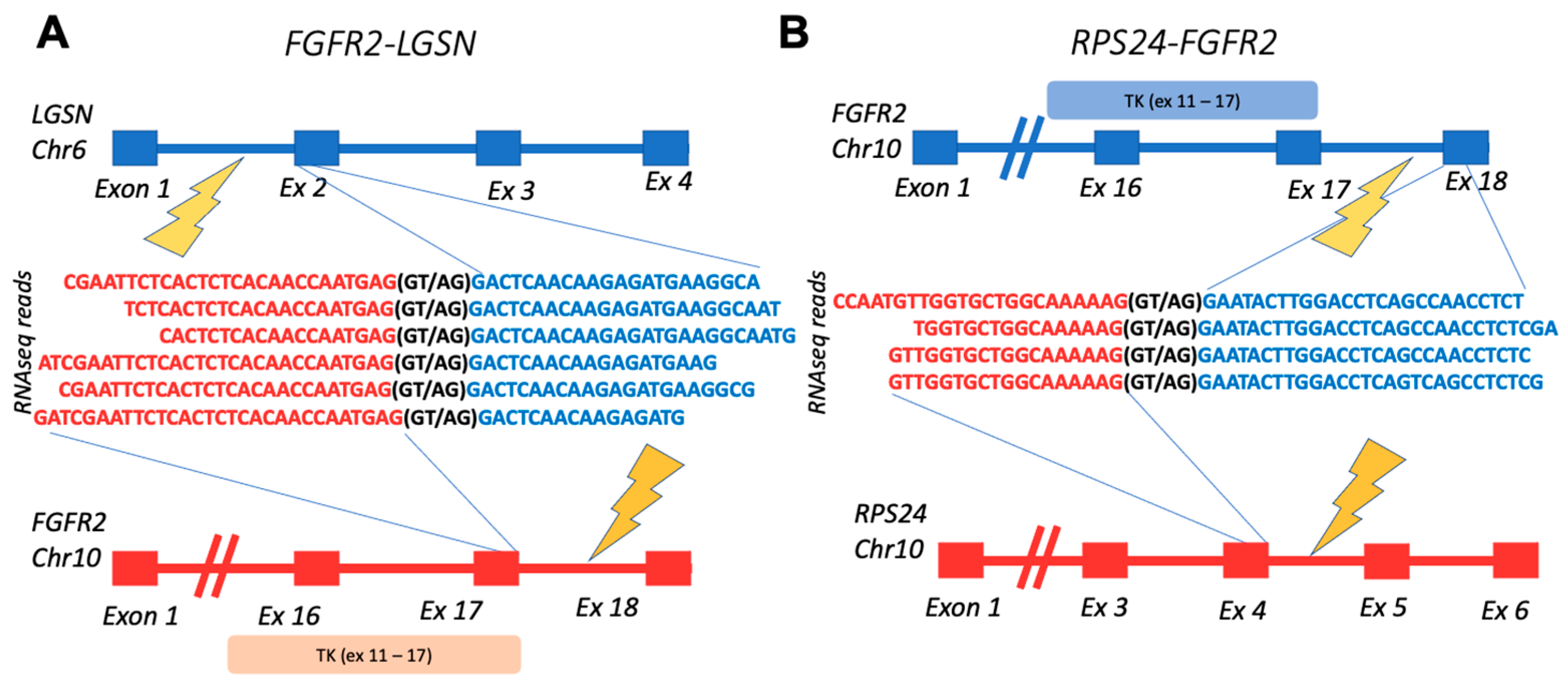
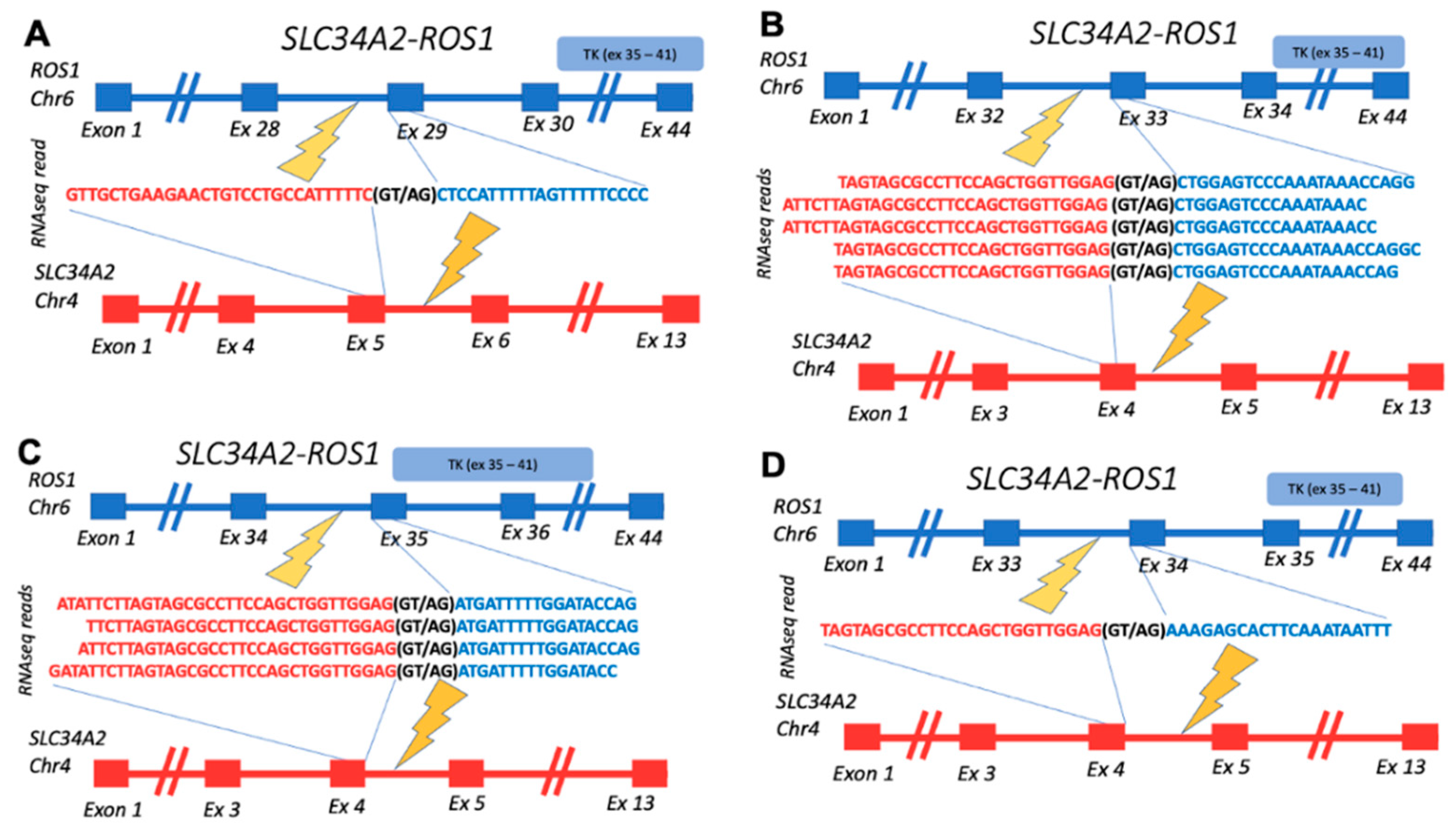
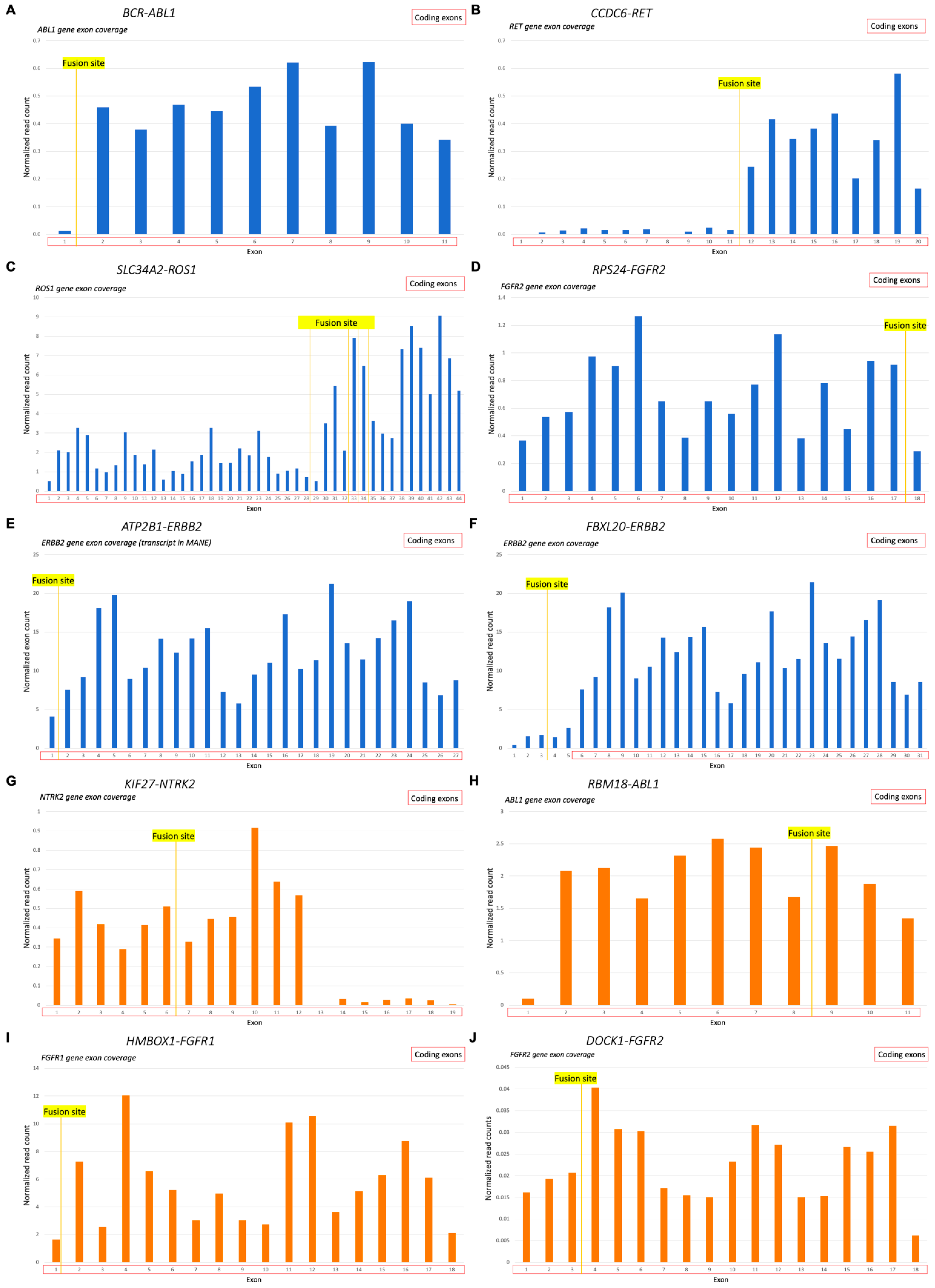
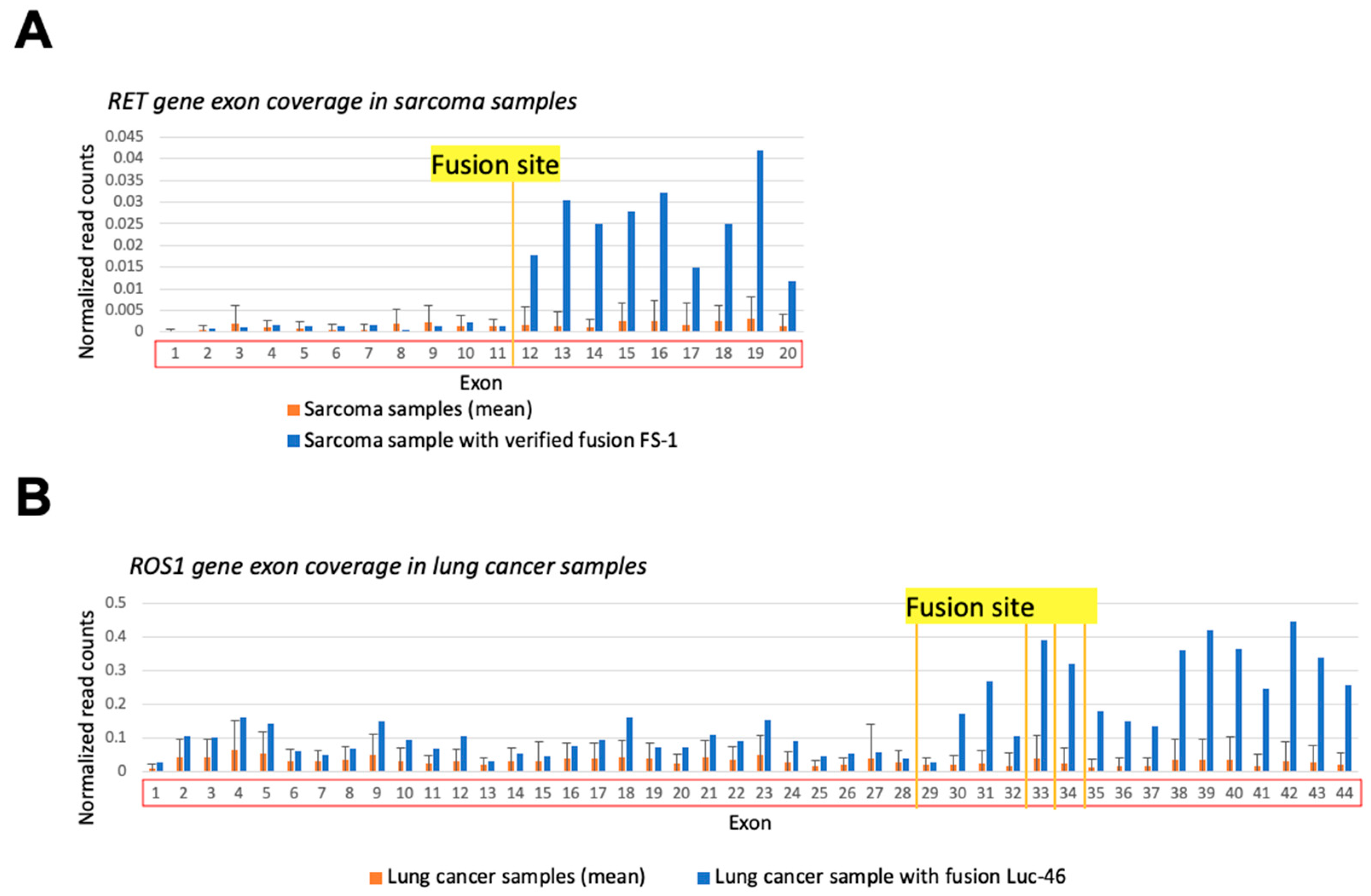
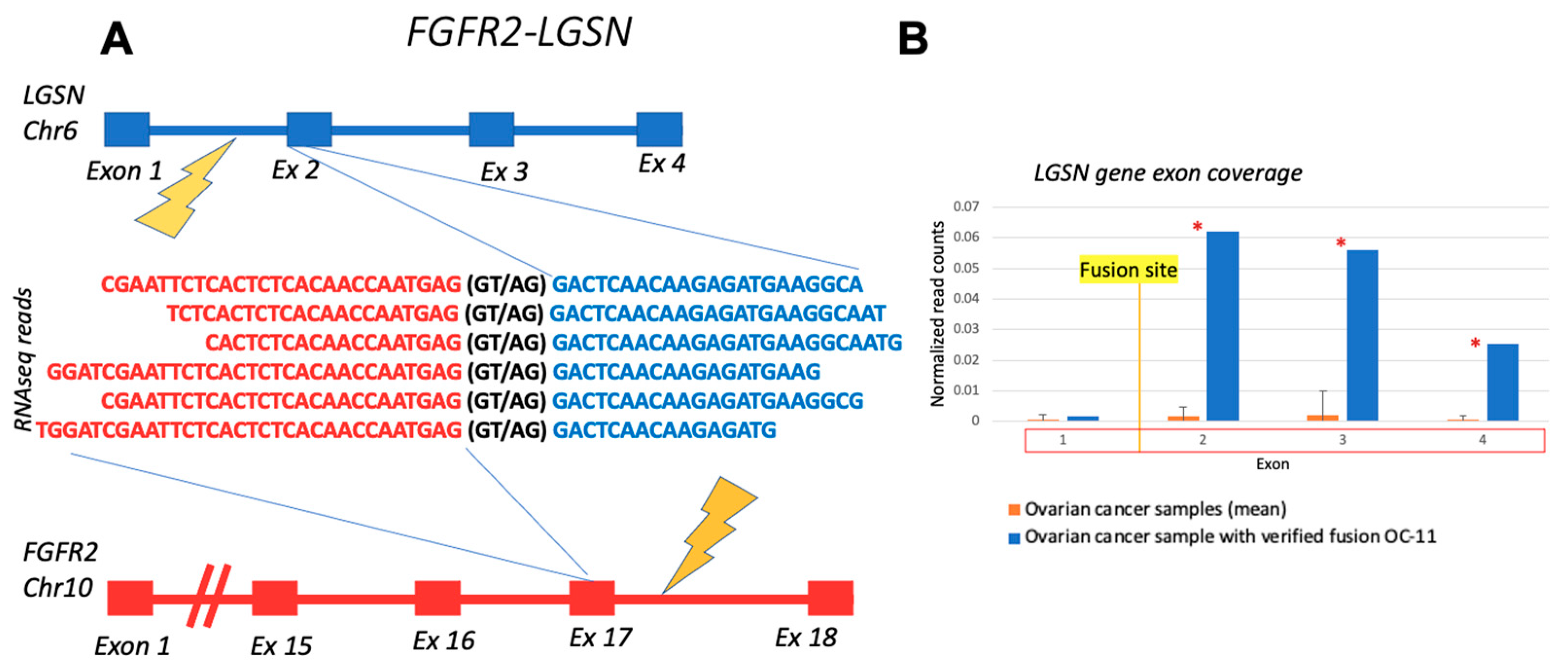
| Sample ID | Fusion Type (5′-3′) | ORF Preserved (Yes/No) 1 | TK Domain Retained (Yes/No) 2 | RTK on 5′/3′ End | Presence in Fusion DBs 3 | Greater RTK Downstream Reads (Yes/No) 4 | Expr. of 5′/3′ Moieties 5 | N Reads 6 |
|---|---|---|---|---|---|---|---|---|
| Experimentally confirmed RTK fusions | ||||||||
| AL-98 | BCR-ABL1 | Yes | Yes | 3′ | Yes | Yes | 1.02/0.47 | 1 |
| FS-1 | CCDC6-RET | Yes | Yes | 3′ | Yes | Yes | 0.4/0.35 | 3 |
| LuC-46 | SLC34A2-ROS1 variant 1 | Yes | Yes | 3′ | Yes | Yes | 24.53/5.29 | 1 |
| LuC-46 | SLC34A2-ROS1 variant 2 | Yes | Yes | 3′ | Yes | Yes | 23.29/6.09 | 5 |
| LuC-46 | SLC34A2-ROS1 variant 3 | Yes | Yes | 3′ | Yes | Yes | 23.29/5.87 | 4 |
| LuC-46 | SLC34A2-ROS1 variant 4 | No | Yes | 3′ | Yes | Yes | 23.29/5.93 | 1 |
| OC-11 | FGFR2-LGSN | Yes | Yes | 5′ | No * | ND | 0.72/0.43 | 6 |
| OC-11 | RPS24-FGFR2 | Yes | No | 3′ | No | No | 5.74/0.29 | 5 |
| BC-105 | FBXL20-ERBB2 | No | Yes | 3′ | Yes | Yes | 1.28/11.77 | 18 |
| BC-105 | ATP2B1-ERBB2 | Yes | Yes | 3′ | No | No | 0.41/12.41 | 8 |
| Experimentally non-confirmed RTK fusions | ||||||||
| GC-30 | ABL1-ALDH1A2 | Yes | No | 5′ | No | ND | 0.04/0.43 | 1 |
| LuC-71 | NTRK2-AL157886.1 | No | No | 5′ | No | ND | NA | 1 |
| LuC-11 | KIF27-NTRK2 | Yes | Yes | 3′ | No | No | 0.02/0.67 | 1 |
| LuC-19 | NTRK2-USP47 | No | No | 5′ | No | ND | 0.83/0.24 | 1 |
| LuC-81 | ETNK1-NTRK2 | No | No | 5′ | No | ND | 0.22/6.36 | 1 |
| XC-1 | FGFR2-NFYC | No | No | 5′ | No | ND | 0.33/0.31 | 1 |
| OC-15 | ABL1-FNIP2 | Yes | No | 5′ | No | ND | 0.45/0.8 | 1 |
| AL-44 | FGFR1-AZIN1 | No | No | 5′ | No | ND | 0.15/0.6 | 1 |
| AL-7 | RET-GART | No | No | 5′ | No | ND | 0.016/0.48 | 1 |
| J1 | RBM18-ABL1 | No | No | 3′ | No | No | 1.94/1.9 | 1 |
| A549 | FGFR1-BRF1 | Yes | No | 5′ | No | ND | 1.21/0.52 | 1 |
| SkC-1 | ABL1-CD59 | No | No | 5′ | No | ND | 0.05/3.58 | 1 |
| BC-59 | FGFR1-REPS2 | No | No | 5′ | No | ND | 0.55/1.5 | 1 |
| EpS-1 | HMBOX1-FGFR1 | No | No | 3′ | No | No | 0.34/5.89 | 1 |
| PC-24 | DOCK1-FGFR2 | Yes | Yes | 3′ | No | No | 0.12/0.023 | 1 |
| Overall specificity | All confirmed vs. non-confirmed | 0.67 | 0.87 | NA | 1 | 1 | NA | 1 (1/>1) |
| Overall sensitivity | All confirmed vs. non-confirmed | 0.8 | 0.9 | NA | 0.7 | 0.78 | NA | 0.7 (1/>1) |
| Putative RTK fusions that were not experimentally investigated by RT-PCR | ||||||||
| TC-123 | NTRK2-MLPH | No | No | 5′ | No | ND | 0.97/0.22 | 1 |
| N-63 | CNTNAP3-NTRK2 | No | No | 3′ | No | Yes | 0.88/0.24 | 8 |
| RAIR-4 | NCOA4-RET | Yes | Yes | 3′ | Yes | Yes | 0.69/0.11 | 1 |
| TC-32 | NTRK2-IARS1 | Yes | No | 5′ | No | ND | 2.55/0.74 | 1 |
| TC-12 | ARHGAP12-ALK | No | Yes | 3′ | No | Yes | 0.46/0.02 | 1 |
| BT-24 | NTRK2-ADAM32 | Yes | Yes | 5′ | No | ND | 0.23/0.006 | 1 |
| BC-47 | FGFR2-RET | Yes | Yes | both | No | No | 0.06/1.36 | 1 |
| FFPE_4-2 | ZNF135-FGFR2 | Yes | Yes | 3′ | No | No | 0.06/0.46 | 1 |
| AL-84 | AGRN-FGFR3 | No | Yes | 3′ | No | Yes | 0.82/0.17 | 1 |
| FFPE-5 | AC016907.2-ALK | No | Yes | 3′ | No | No | NA | 1 |
| INI-1 | KIF5C-NTRK3 | Yes | No | 3′ | No | Yes | 1.17/0.19 | 1 |
Publisher’s Note: MDPI stays neutral with regard to jurisdictional claims in published maps and institutional affiliations. |
© 2022 by the authors. Licensee MDPI, Basel, Switzerland. This article is an open access article distributed under the terms and conditions of the Creative Commons Attribution (CC BY) license (https://creativecommons.org/licenses/by/4.0/).
Share and Cite
Rabushko, E.; Sorokin, M.; Suntsova, M.; Seryakov, A.P.; Kuzmin, D.V.; Poddubskaya, E.; Buzdin, A.A. Experimentally Deduced Criteria for Detection of Clinically Relevant Fusion 3′ Oncogenes from FFPE Bulk RNA Sequencing Data. Biomedicines 2022, 10, 1866. https://doi.org/10.3390/biomedicines10081866
Rabushko E, Sorokin M, Suntsova M, Seryakov AP, Kuzmin DV, Poddubskaya E, Buzdin AA. Experimentally Deduced Criteria for Detection of Clinically Relevant Fusion 3′ Oncogenes from FFPE Bulk RNA Sequencing Data. Biomedicines. 2022; 10(8):1866. https://doi.org/10.3390/biomedicines10081866
Chicago/Turabian StyleRabushko, Elizaveta, Maxim Sorokin, Maria Suntsova, Alexander P. Seryakov, Denis V. Kuzmin, Elena Poddubskaya, and Anton A. Buzdin. 2022. "Experimentally Deduced Criteria for Detection of Clinically Relevant Fusion 3′ Oncogenes from FFPE Bulk RNA Sequencing Data" Biomedicines 10, no. 8: 1866. https://doi.org/10.3390/biomedicines10081866
APA StyleRabushko, E., Sorokin, M., Suntsova, M., Seryakov, A. P., Kuzmin, D. V., Poddubskaya, E., & Buzdin, A. A. (2022). Experimentally Deduced Criteria for Detection of Clinically Relevant Fusion 3′ Oncogenes from FFPE Bulk RNA Sequencing Data. Biomedicines, 10(8), 1866. https://doi.org/10.3390/biomedicines10081866








